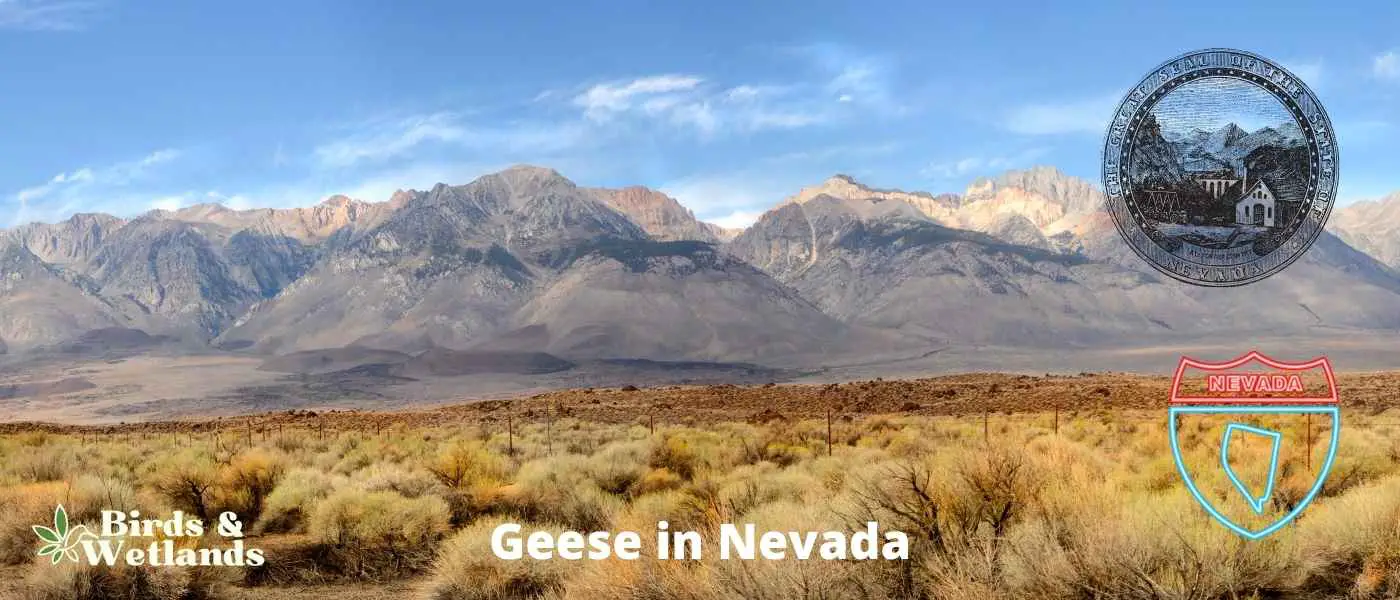For the bird watchers out there, Nevada offers a great opportunity to see geese. There are several places in the state where these birds can be found.
We provide some information about where to go and what you can expect to see. So, if you’re looking for an exciting birding adventure, read on!
What Geese Are in Nevada?
Nevada is home to six species of goose and two species of swans.
- Canada Goose
- Snow Goose
- Ross’s Goose
- Cackling Goose
- Greater White-fronted Goose
- Brant
Swans in Nevada include Trumpeter Swan and Tundra Swan.
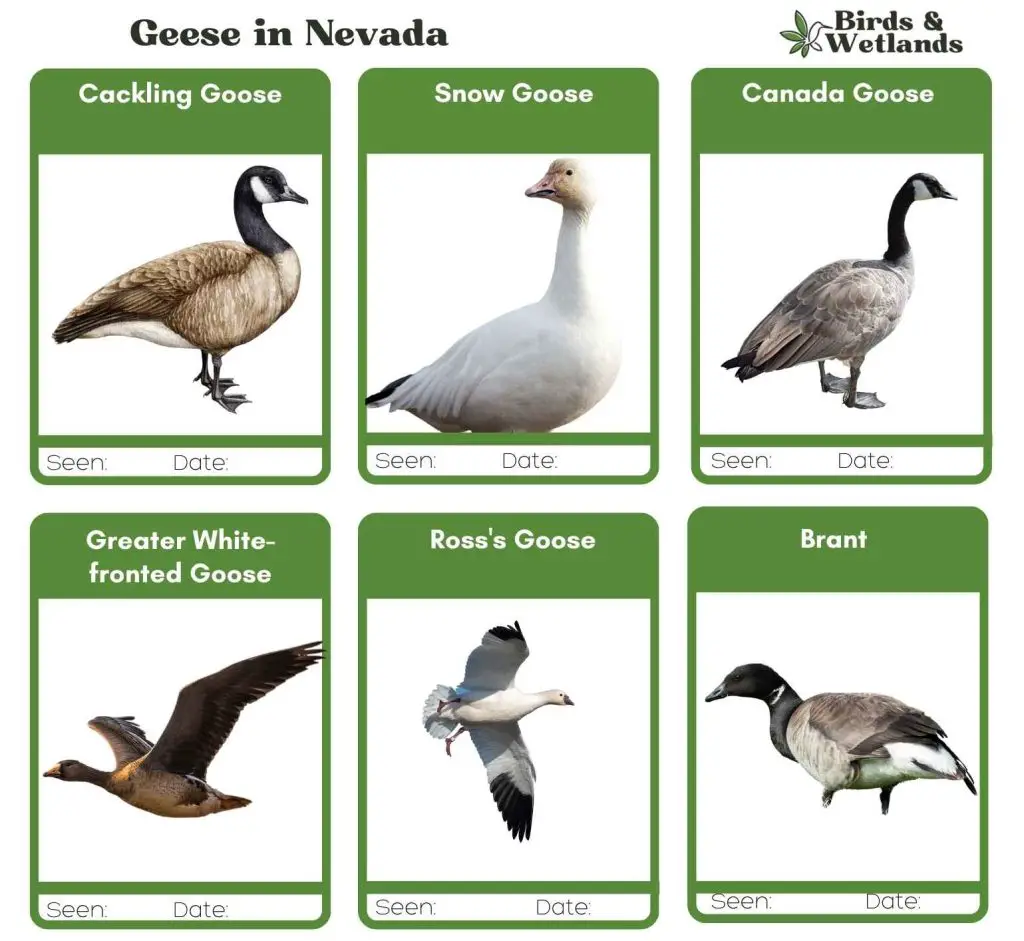
Canada Goose


Canada Goose Sound
Scientific Name: Branta canadensis
Length: 30 to 43 in
Wingspan: 50–73 in
Weight: 5.7–14.3 lb
The Canada Goose is a large, well-known species of waterfowl noted for its distinctive appearance, familiar “honk,” and migratory behavior.
Appearance: Both male and female Canada Geese have a similar appearance, featuring a black head and neck with distinctive white patches on the cheeks and chin. The body is primarily brown with a lighter, often white, underbelly.
Diet: Canada Geese primarily feed on plant matter, including grasses, aquatic vegetation, and grains. They can often be seen grazing in parks, lawns, and fields, as well as dabbling in water bodies.
Reproduction: Canada Geese typically nest on the ground near water bodies, often on islands or other isolated areas to avoid predators. The female lays a clutch of about 4 to 6 eggs, which she incubates alone for around a month.
Snow Goose

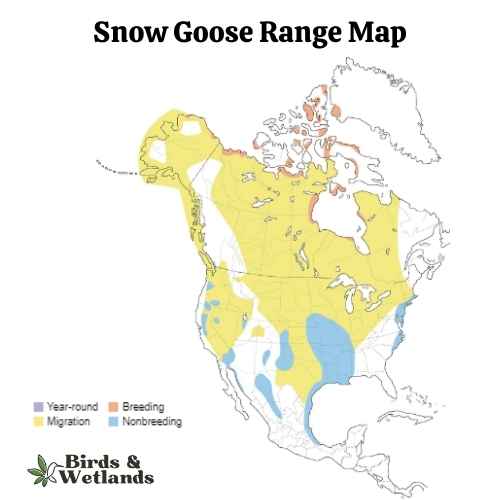
Snow Goose Sound
Scientific Name: Anser caerulescens
Length: 25 to 31 in
Wingspan: 53 to 65 in
Weight: 4.5 to 6.0
The Snow Goose is a large species of waterfowl known for its vibrant white plumage and significant migratory flights.
Appearance: True to their name, Snow Geese are predominantly white with black wingtips. They also have a pink bill, pink legs and feet. A color morph, known as the “Blue Goose,” displays a bluish-gray body with a white head, but is considered the same species.
Diet: Snow Geese primarily feed on plant matter, such as grasses, sedges, and small grains. They can often be seen in large flocks foraging in fields and marshes, and during migration and winter, they can cause considerable damage to agricultural fields due to their feeding habits.
Reproduction: Snow Geese typically nest on the tundra, near water bodies. The female builds the nest and lays a clutch of about 3 to 5 eggs, which she incubates alone for approximately three weeks. Once hatched, the goslings can feed themselves but stay with their parents for protection until they can fly.
Ross’s Goose
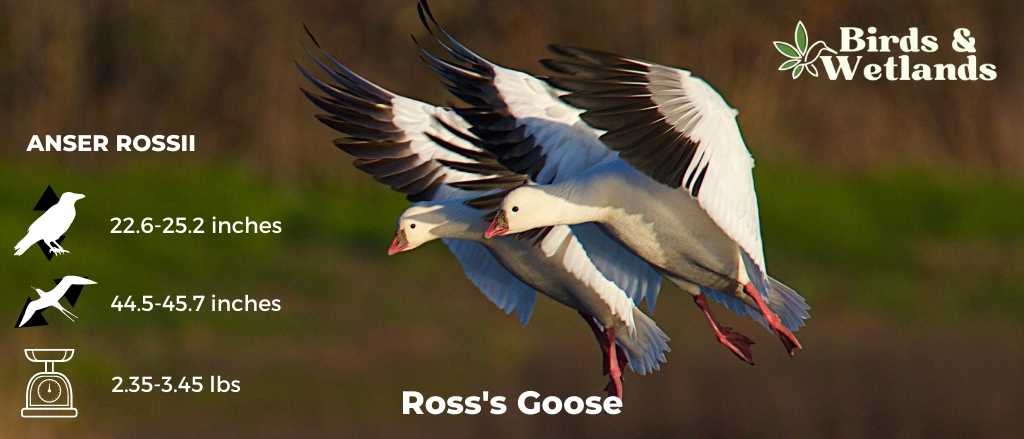
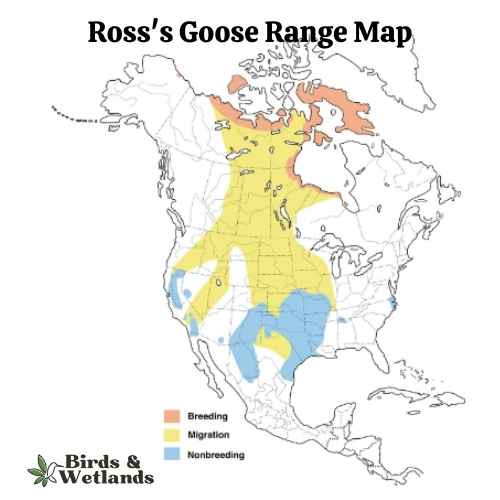
Listen
Scientific Name: Anser rossii
Length: 23.2-25.2
Wingspan: 44.5-45.7 in
Weight:42.3-55.3 oz
The Ross’s Goose is a small species of waterfowl often found in North America’s tundra and wetland habitats.
Appearance: Known for its compact size, the Ross’s Goose is mostly white with black wingtips. It features a short, stubby bill and a rounded head. One key identifying feature is the blueish gray base of its bill, which has a warty structure during the breeding season.
Diet: This goose feeds mainly on vegetation, including seeds, leaves, and roots of grasses and sedges. During winter and migration, they also consume grains and seeds from agricultural fields.
Reproduction: The Ross’s Goose nests on the ground, often in colonies. The female lays a clutch of 2 to 5 eggs which she incubates for around three weeks. The young geese, known as goslings, are precocial – they can walk, swim, and feed themselves shortly after hatching, although they stay with their parents until they learn to fly.
Cackling Goose
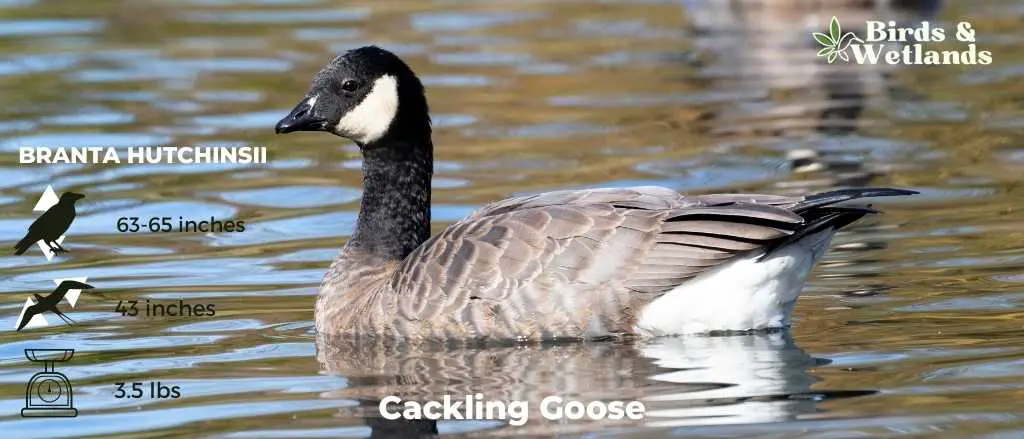
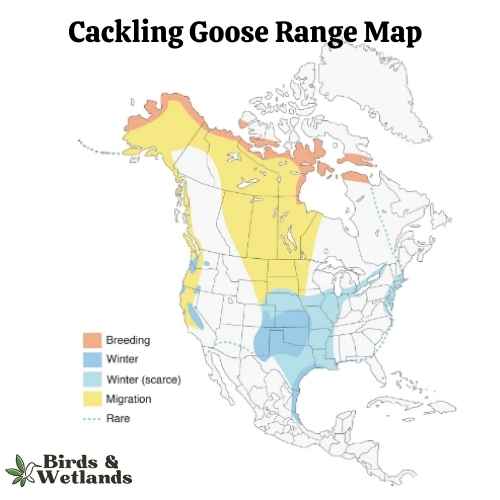
Listen
Scientific Name: Branta hutchinsii
Length: 24.8–25.6 in
Wingspan: 43-45.7 in
Weight:3.5 lbs
Cackling Geese are particularly known for their high-pitched, cackling calls, which is the source of their name. Despite their small size, these geese are renowned long-distance migrants, with some populations traveling thousands of miles between breeding and wintering grounds.
Appearance: With a similar color pattern to the larger Canada Goose, the Cackling Goose features a black head and neck, white chinstrap, light tan to cream chest, and brownish-grey body. One defining characteristic is its noticeably smaller size and stubbier neck compared to its larger counterparts.
Diet: Like many geese, the Cackling Goose’s diet mainly consists of plant matter. This includes grasses, seeds, and aquatic vegetation. They are often seen grazing on land or dabbling in shallow water.
Reproduction: Cackling Geese usually nest on the ground in elevated areas near water bodies, such as riverbanks or lakeshores. The female lays a clutch of 2 to 8 eggs and is responsible for incubation, while the male stands guard nearby. Incubation lasts for about a month.
Greater White-fronted Goose
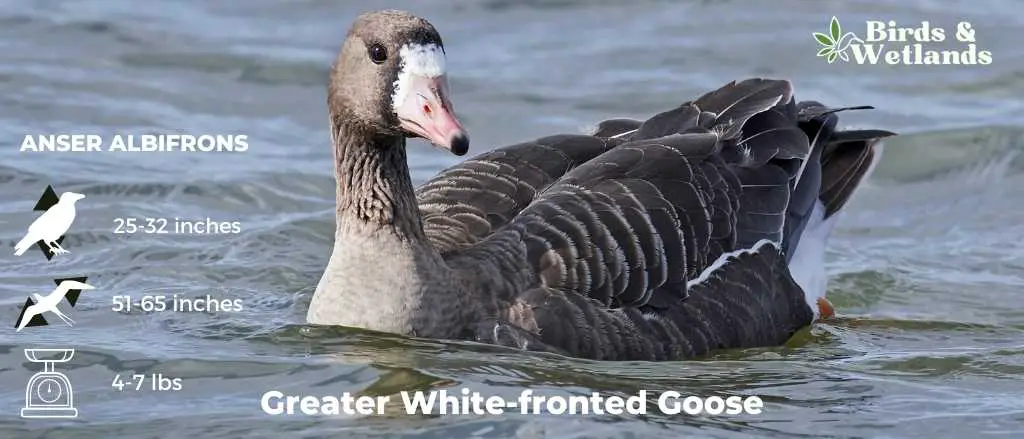

Listen
Scientific Name: Anser albifrons
Length: 25 to 31 in
Wingspan: 53 to 66 in
Weight: 3.3 to 6.6
The Greater White-fronted Goose is a medium to large waterfowl species, widely distributed across the Northern Hemisphere, particularly in North America.
Appearance: As the name suggests, these geese display a prominent white patch at the base of their bill. Their bodies are gray-brown, and their breasts are often marked with dark blotches. They possess a pinkish bill and orange legs and feet.
Diet: The Greater White-fronted Goose is a herbivore and feeds mainly on plant material. Its diet consists of grasses, sedges, grains, and berries. When wintering, these geese can often be found in agricultural fields, feasting on leftover grains and crops.
Reproduction: This species nests on the ground, often in areas with good visibility such as slopes or ridges. The female lays a clutch of 4 to 5 eggs, which she incubates for nearly a month. Once hatched, the young ones are taken care of by both parents until they are able to fly.
Brant

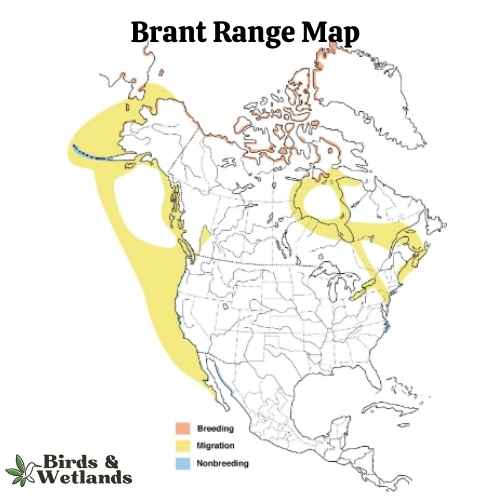
Listen
Scientific Name: Branta bernicla
Length: 22–26 in
Wingspan: 42–48 in
Weight: 1.9–4.9 lb
The Brant is a compact species of goose that is known for its striking appearance and interesting migratory patterns.
Appearance: The Brant is recognized for its dark, sooty color with a white crescent on the neck. The body is mostly black to dark gray, contrasting with the lighter underparts. Its small size, as compared to other geese, and short, stubby bill are other distinct features.
Diet: The Brant’s diet primarily consists of aquatic plants, especially eelgrass and sea lettuce. During the breeding season, they may also feed on grasses, sedges, and insects.
Reproduction: Brants typically breed in the high Arctic tundra. The female lays a clutch of 3 to 5 eggs in a ground nest, which she incubates for about a month.
Notably, Brants make an impressive long-distance migration every year. They spend their winters along both the east and west coasts of the United States and travel to the Arctic regions of Canada, Alaska, and even Russia to breed.
Hunting Geese in Nevada
In Nevada, goose hunting is regulated by the Nevada Department of Wildlife (NDOW).
The NDOW sets the dates for the hunting season, defines the areas where hunting is permitted and establishes the bag limits for each hunter.
Goose hunting is only permitted in certain areas of the state, and hunters are required to possess a valid hunting license and a stamp authorizing them to hunt waterfowl.
Can You Shoot a Goose in Nevada?
In the state of Nevada, it is legal to shoot geese with a shotgun that has been plugged to limit the overall shotshell capacity to three. This rule applies to all migratory birds.
Additionally, Nevada has a daily bag limit of 5 and a possession limit of 15 for Canada Geese and Brant, 10 daily bag and 30 possession limit for White-fronted Geese and 20 daily and 60 possession limit for Snow and Ross’ Geese.
Where Can I Hunt Geese in Nevada?
Nevada’s Stillwater National Wildlife Reserve is widely considered to be one of the best places to hunt geese in the state.
The reserve is home to a large population of geese, and the expansive wetlands provide ample opportunity for hunters to bag their limit. The reserve offers a variety of other hunting opportunities, including waterfowl, upland game, and big game.
Is There a Goose Hunting Season in Nevada?
The goose hunting season in Nevada usually takes place from October to January.
Take Away on Geese in Nevada
If you’re looking for an interesting birding destination, Nevada is a great place to start. With six different goose species and two types of swans, there’s something for everyone. Whether you’re a beginner or an experienced birder, Nevada is sure to impress.

